Las luchadoras vs el Médico Asesino [The Wrestling Women vs. the Murderous Doctor]
(Cin. Calderón, 1962)* Prod: Guillermo Calderón Stell; Dir:
René Cardona [Sr.]; Scr: Alfredo Salazar; Photo: Enrique Wallace;
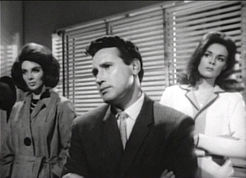 Music Dir: Antonio Díaz Conde; Prod Chief: Fidel Pizarro; Film Ed:
Jorge Bustos; Art Dir: José Rodríguez Granada; Makeup:
Felisa Ladrón de Guevara; Sound: Javier Mateos
Music Dir: Antonio Díaz Conde; Prod Chief: Fidel Pizarro; Film Ed:
Jorge Bustos; Art Dir: José Rodríguez Granada; Makeup:
Felisa Ladrón de Guevara; Sound: Javier Mateos
*[English-language version: Doctor of Doom (Young America Prods.) Prod: K. Gordon Murray; Dir: Manuel San Fernando; character names in dubbed version are listed below in brackets]
This film was later re-released in an English-dubbed version as Rock n' Roll Wrestling Women vs. the Aztec Ape (with an altered soundtrack).
CAST: Lorena Velázquez (Gloria Venus), Armando Silvestre (Armando Campos [Mike Henderson]), Elizabeth Campbell (Golden Rubí), Roberto Cañedo (Prof. Ruiz [Prof. Wright]), Sonia Infante (Alicia [Alice]), Chucho Salinas (Chema [Tommy Johnson]), Chabela Romero (Carmela Camacho "Vendetta"); women wrestlers: Martha "Güera" Solis, Magdalena Caballero, Toña "La Tapatía," Irma Rodríguez?; Julien de Meriche (wrestling impresario [Dick]), Jorge Mondragón (Boris), Jesús "Murciélago" Velázquez (Marcado), "Cavernario" Galindo, "Picoro" (ring announcer), Gerardo Zepeda (Gomar), Victorio Blanco? (arena doorkeeper), Armando Acosta (chief of Secret Service [Inspector Rogers]), Manuel Garay (police agent)
NOTES: Alfredo Salazar is a somewhat unsung figure in the annals of
Mexican cinema, toiling as he did for years as a screenwriter before
receiving the opportunity to direct (a vocation which he did not exercise
too frequently). Salazar's script for Las luchadoras vs. el
Médico Asesino took elements of horror and wrestling (from
Ladrón de cadáveres, particularly) and added a bit of
sexual titillation. The concept of wrestling women was popular
enough to inspire a series of six Calderón films: Las luchadoras
vs. el Médico Asesino, Las luchadoras vs. la momia ('64),
Las lobas del ring ('64), Las mujeres panteras ('66), Las
luchadoras vs. el robot asesino ('68) and El horripilante bestia
humana ('68--although this featured only 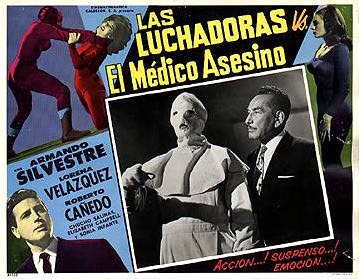 one
female wrestler).
The last two films were unofficial remakes of Las
luchadoras vs. el Médico Asesino (although Salazar was only
credited on Robot asesino), but with added gore and nudity that
would have been prohibited just six years earlier. Three of the series
were dubbed into English: Doctor of Doom (Médico Asesino),
Wrestling Women vs. the Aztec Mummy (Las luchadoras vs. la momia), and
Night of the Bloody Apes (Horripilante bestia).
one
female wrestler).
The last two films were unofficial remakes of Las
luchadoras vs. el Médico Asesino (although Salazar was only
credited on Robot asesino), but with added gore and nudity that
would have been prohibited just six years earlier. Three of the series
were dubbed into English: Doctor of Doom (Médico Asesino),
Wrestling Women vs. the Aztec Mummy (Las luchadoras vs. la momia), and
Night of the Bloody Apes (Horripilante bestia).
Professor Ruiz and his assistant Boris are trying to create a race of superhumans via brain transplants. One of their failed experiments, Gomar, is a brutish creature who is kept in a cage and fed raw meat. Perhaps for this reason, Ruiz has now switched to transplanting brains into women, with no discernable success. One of his "donors" is Alicia, whose sister is professional wrestler Gloria Venus. Ruiz starts to think that perhaps a female athlete might be a better subject for his medical hijinks: he sends Gomar and some (human) henchmen after Gloria and her new friend, wrestler Rubí, but the women best their attackers.
Gloria and
Rubí become friends with Armando and Chema, two police agents
trying to solve the mystery. Boris is captured but is killed before he
can identify Ruiz as the mad killer; Chema and Armando are kidnaped by
Ruiz, but are saved by Gloria and Rubí. In the struggle, Ruiz has
acid thrown in his face, and the laboratory catches fire.
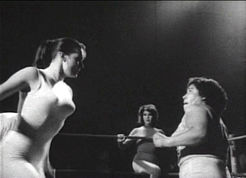
However, Ruiz survives and transplants Gomar's brain into a woman wrestler's body; he names the resulting creation "Vendetta" (since Gomar is male, this is actually a sort of sex-change operation for him). Vendetta wrestles Gloria and is gaining the upper hand, when Rubí spots Marcado, one of Ruiz's henchmen, in the arena. Marcado, under pressure, admits Vendetta's masked manager is really the scarred Ruiz. The police are alerted, and Vendetta and Ruiz flee to the top of a nearby tower. Armando climbs up in pursuit, but is nearly killed; Chema shoots and kills Ruiz and Vendetta.
El horripilante bestia humana and Las luchadoras vs. el
robot asesino each borrow portions of this film's plot (Gerardo Zepeda
appears in all three films as the monster, called "Carfax" in El
horripilante bestia humana and unnamed in the latter title); the
additional gore and nudity (visible in the dubbed prints of
Horripilante, assumed in Robot asesino, since the "nude"
version of this film does not seem to be available) actually make these
films somewhat more entertaining than their progenitor. René
Cardona directed all six of the "luchadora" films: in Las luchadoras
vs. el Médico Asesino, he plays around a little in the early
scenes, always showing the mad scientist wearing a surgical mask, a
full-head hood, or (rather awkwardly) only from the chest down, in an
attempt to disguise the character's "secret" identity.
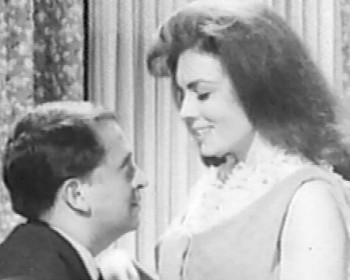
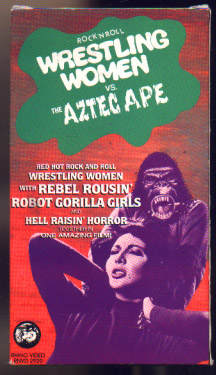
Oddly enough, while the "arena" wrestling scenes feature Lorena Velázquez doing some of her own stunts, she and Elizabeth Campbell are (somewhat obviously) doubled in most of the other action sequences (particularly one where Marcado and another henchman attack Gloria and Rubí in their bedroom). In general, actual women wrestlers of this era (some appear in the film as themselves) were stocky and not exactly movie-star beautiful (to put it mildly), and thus the mostly-doubled wrestling and action sequences are the least entertaining aspects of these films (this wasn't an issue for Santo, Blue Demon, etc., who were wrestlers first and "acted" by virtue of dubbed dialogue).
Médico Asesino set the pace for the rest of the series, with relatively little character development or "nonessential" material (although there is some "comic" relief centered around the diminutive Chema's "romance" with the statuesque Rubí, a twist eliminated in Robot asesino by substituting Héctor Lechuga and Malú Reyes for Chucho Salinas and Elizabeth Campbell).
Another trivia point: although there was a professional wrestler called
"El Médico Asesino" (who in fact was the hero in El
Enmascarado de Plata in 1952 and a villainous wrestler in
Huracán Ramírez the same year), this film does not
feature his character (although its title seems to have been calculated to
exploit his fame). The picture would have more appropriately been called
something like "Las luchadoras contra el sabio loco" (The Wrestling Women
vs. the Mad Genius).
Thanks to the WOM!WAM! page for vidcap above.
Posted 31 May 99 by dwilt@umd.edu
New photos added 22 June 2001.